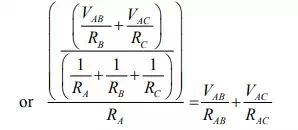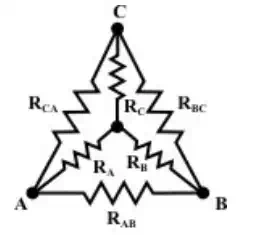Conversion from Delta (Δ) to Star or Wye (Y)

Between A & C terminals:
 (1)
(1)
Between C B & terminals:
 (2)
(2)
Between B & A terminals:
 (3)
(3)
By combining above three equations, one can write an expression as given below
 (4)
(4)
Subtracting equations (2), (1), and (3) from (4) equations, we can write the express for unknown resistances of Wye (Y ) network as

Conversion from Star or Wye (Y) to Delta (Δ)
![]()
![]()
![]()

Appling KCL at ‘ N ’ for Y connected network (assume A, , B C terminals having higher potential than the terminal N ) we have,

For Δ-network
Current entering at terminal A = Current leaving the terminal ‘ A’

From equations
![]()


Equating the
coefficients of ![]() and
and ![]() in both sides of eq, we
obtained the following relationship.
in both sides of eq, we
obtained the following relationship.


Equating the above two equations and using the value of Eq. 9, we get the final expression as

Equating the coefficient
of ![]() in
both sides of the above equations we obtain the following relation
in
both sides of the above equations we obtain the following relation
 (14)
(14)
When we need to transform a Delta (Δ ) network to an equivalent Wye (Y ) network, the equations (5) to (7) are the useful expressions. On the other hand, the equations (12) – (14) are used for Wye (Y ) to Delta (Δ ) conversion.
Observations
In order to note the symmetry of the transformation equations, the Wye (Y ) and Delta (Δ ) networks have been superimposed on each other as shown in fig.

· The equivalent star (Wye) resistance connected to a given terminal is equal to the product of the two Delta (Δ) resistances connected to the same terminal divided by the sum of the Delta (Δ) resistances.
· The equivalent Delta ( ) resistance between two-terminals is the sum of the two-star (Wye) resistances connected to those terminals plus the product of the same two-star (Wye) resistances divided by the third star (Wye (Y )) resistance